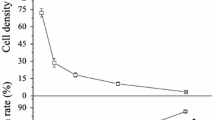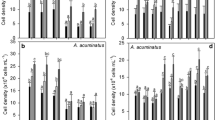Abstract
Plant-derived allelochemicals have the potential to be used as eco-friendly measures for control of Microcystis aeruginosa blooms. However, the susceptibility of M. aeruginosa to plant allelochemicals under a range of environmental factors, such as alkalinity, is not clear. This study investigated the effects of different alkalinity treatments on 1,2,3-trihydroxybenzene (pyrogallol) toxicity to a toxic strain of the cyanobacterium, M. aeruginosa (FACHB 905). Pyrogallol toxicity to M. aeruginosa cultures, both pre-adapted to a range of alkalinity levels and un-adapted, increased when alkalinity was increased from 0.09 to 1.51 meq L−1. The mean inhibition ratios calculated according to OD650, cell concentration, Chl a, and carotenoid concentrations of M. aeruginosa cultures were highest in the highest alkalinity treatment (1.51 meq L−1), i.e., up to 74%, 80%, 73%, and 87% for alkalinity-adapted cells on day 3. The lowest cell concentrations and photosynthesis pigment concentrations were found in the highest alkalinity treatment (1.51 meq L−1) for un-adapted cells in 12-day bioassays. This trend was more obvious over time. Pyrogallol and TPC (total phenolic compounds) concentrations measured immediately after pyrogallol addition into the culture medium decreased more rapidly in higher alkalinity treatments. In contrast, faster oxygen consumption and higher production of quinone end products occurred within the first 30 min after pyrogallol addition at higher alkalinity levels. Quinones and oxygen radicals have been shown previously to be more toxic to cyanobacteria than pyrogallol itself. This provides a potential explanation for the enhanced pyrogallol toxicity to M. aeruginosa under higher alkalinity. Therefore, it is important to take alkalinity into account when considering pyrogallol as a potential biocide.




Similar content being viewed by others
References
Bates D, Maechler M, Bolker B (2012) Lme4: linear mixed-effects models using S4 classes. R package version: 0.999999-0. R Foundation for Statistical Computing, Vienna
Bährs H, Laue P, Chakrabarti S, Steinberg CEW (2014) Plant polyphenols: do they control freshwater planktonic nuisance phototrophs? In: Watson R (ed) Polyphenols in plants: isolation, purification and extract preparation. Academic Press, Massachusetts, USA, pp 87–98
Bährs H, Putschew A, Steinberg CEW (2013) Toxicity of hydroquinone to different freshwater phototrophs is influenced by time of exposure and pH. Environ Sci Pollut Res 20:146–154
Bell TAS, Sen-Kilic E, Felföldi T, Vasas G, Fields MW, Peyton BM (2018) Microbial community changes during a toxic cyanobacterial bloom in an alkaline Hungarian lake. Antonie van Leeuwenhoek 111:2425–2440
Carvalho L, Miller CA, Scott EM, Codd GA, Davies PS, Tyler AN (2011) Cyanobacterial blooms: statistical models describing risk factors for national-scale lake assessment and lake management. Sci Total Environ 409:5353–5358
Carvalho H, Mcdonald C, de Hoyos C, Mischke U, Phillips G, Borics G, Poikane S, Skjelbred B, Solheim AL, Wichelen JV, Cardoso AC (2013) Sustaining recreational quality of European lakes: minimizing the health risks from algal blooms through phosphorus control. J Appl Ecol 50:315–323
Chen Y, Qin B, Teubner K, Dokulil MT (2003) Long-term dynamics of phytoplankton assemblages: Microcystis-domination in Lake Taihu, a large shallow lake in China. J Plankton Res 25:445–453
Dunnivant FM (2005) Environmental laboratory exercises for instrumental analysis and environmental chemistry, John Wiley & Sons, Inc. NJ, USA
Gao YN, Dong J, Fu QQ, Wang YP, Chen C, Li JH, Li R, Zhou CJ (2017a) Allelopathic effects of submerged macrophytes on phytoplankton. Allelopath J 40:1–22
Gao YN, Ge FJ, Zhang LP, He Y, Lu ZY, Zhang YY, Liu BY, Zhou QH, Wu ZB (2017b) Enhanced toxicity to the cyanobacterium Microcystis aeruginosa by low-dosage repeated exposure to the allelochemical N-phenyl-1-naphthylamine. Chemosphere 174:732–738
Geddie AW, Hall SG (2019) The effect of salinity and alkalinity on growth and the accumulation of copper and zinc in the Chlorophyta Ulva fasciata. Ecotoxicol Environ Saf 172:203–209
Harke MJ, Steffen MM, Gobler CJ, Otten TG, Wilhelm SW, Wood SA, Paerl HW (2016) A review of the global ecology, genomics, and biogeography of the toxic cyanobacterium, Microcystis spp. Harmful Algae 54:4–20
Huisman J, Codd GA, Paerl HW, Ibelings BW, Verspagen JMH, Visser PM (2018) Cyanobacterial blooms. Nat Rev Microbiol 16:471–483
Jones GJ, Orr PT (1994) Release and degradation of microcystin following algicide treatment of a Microcystis aeruginosa bloom in a recreational lake, as determined by HPLC and protein phosphatase inhibition assay. Water Res 28:871–876
Kahara SN, Vermaat JE (2003) The effect of alkalinity on photosynthesis–light curves and inorganic carbon extraction capacity of freshwater macrophytes. Aquat Bot 75:217–227
Körner S, Nicklisch A (2002) Allelopathic growth inhibition of selected phytoplankton species by submerged macrophytes. J Phycol 871:862–871
Krüger T, Hölzel N, Luckas B (2012) Influence of cultivation parameters on growth and microcystin production of Microcystis aeruginosa (Cyanophyceae) isolated from Lake Chao (China). Microb Ecol 63:199–209
Lei YZ (2006) Environmental chemistry experiment of aquaculture water. China Agriculture Press, Beijing
Lichtenthaler HK, Buschmann C (2001) Chlorophylls and carotenoids: measurement and characterization by UV-VIS spectroscopy. Curr Protoc Food Anal Chem 1:F4.3.1–F4.3.8
Liu BY, Zhou PJ, Tian JR, Jiang SY (2007) Effect of pyrogallol on the growth and pigment content of cyanobacteria-blooming toxic and nontoxic microcystis aeruginosa. Bull Environ Contam Toxicol 78:499–502
Lu Y, Wang J, Yu Y, Su W, Kong FX (2013) Inhibition of Camellia sinensis (L.) O. Kuntze on Microcystis aeruginosa and isolation of the inhibition factors. Biotechnol Lett 35:1029–1034
Lu Z, Sha J, Tian Y, Zhang XZ, Liu BY, Wu ZB (2017) Polyphenolic allelochemical pyrogallic acid induces caspase-3(like)-dependent programmed cell death in the cyanobacterium Microcystis aeruginosa. Algal Res 21:148–155
Lu Z, Zhang Y, Gao Y, Liu BY, Sun XM, He F, Zhou QH, Wu ZB (2016) Effects of pyrogallic acid on Microcystis aeruginosa: oxidative stress related toxicity. Ecotoxicol Environ Saf 132:413–419
Lu ZY, Liu B Y, He Y, Chen Z L, Zhou Q H, Wu Z B (2014) Effects of daily exposure of cyanobacterium and chlorophyte to low-doses of pyrogallol. Allelopath J 34:195–205
Maileht K, Nõges T, Nõges P, Ott I, Mischke U, Carvalho L, Dudley B (2013) Water colour, phosphorus and alkalinity are the major determinants of the dominant phytoplankton species in European lakes. Hydrobiologia 704:115–126
Marcé R, Obrador B, Morguí J-A, Riera JL, López P, Armengol J (2015) Carbonate weathering as a driver of CO2 supersaturation in lakes. Nat Geosci 8:107–111
Miller T, Mackay W (1980) The effects of hardness, alkalinity and pH of test water on the toxicity of copper to rainbow trout (Salmo gairdneri). Water Res 14:129–133
Nakai S, Asaoka S, Okuda T, Nishijima W (2014) Growth inhibition of Microcystis aeruginosa by allelopathic compounds originally isolated from Myriophyllum spicatum: temperature and light effects and evidence of possible major mechanisms. J Chem Eng Japan 47:488–493
Nakai S, Inoue Y, Hosomi M, Murakami A (2000) Myriophyllum spicatum -released allelopathic polyphenols inhibiting growth of blue-green algae Microcystis aeruginosa. Water Res 34:3026–3032
Nguyen BT, Rittmann BE (2016) Effects of inorganic carbon and pH on growth kinetics of Synechocystis sp. PCC 6803. Algal Res 19:363–369
Oberholster PJ, Botha AM, Ashton PJ (2009) The influence of a toxic cyanobacterial bloom and water hydrology on algal populations and macroinvertebrate abundance in the upper littoral zone of Lake Krugersdrift, South Africa. Ecotoxicology 18:34–46
Paerl HW, Otten TG (2013) Harmful cyanobacterial blooms: causes, consequences, and controls. Microb Ecol 65:995–1010
Pillinger JM, Cooper JA, Ridge I (1994) Role of phenolic compounds in the antialgal activity of barley straw. J Chem Ecol 20:1557–1569
R Development Core Team R (2011) R: a language and environment for statistical computing. R Found Stat Comput 1:409
Ramasarma T, Rao AVS, Devi MM, Omkumar RV, Bhagyashree KS, Bhat SV (2014) New insights of superoxide dismutase inhibition of pyrogallol autoxidation. Mol Cell Biochem 400:277–285
Rippka R, Deruelles J, Waterbury JB (1979) Generic assignments, strain histories and properties of pure cultures of cyanobacteria. J Gen Microbiol 111:1–61
Sandrini G, Ji X, Verspagen JMH, Tann RP, Slot PC, Luimstra VM, Schuurmans JM, Matthijs HCP, Huisman J (2016) Rapid adaptation of harmful cyanobacteria to rising CO2. Proc Natl Acad Sci 113:9315–9320
Sandrini G, Matthijs HCP, Verspagen JMH, Muyzer G, Huisman J (2014) Genetic diversity of inorganic carbon uptake systems causes variation in CO2 response of the cyanobacterium Microcystis. ISME J 8:589–600
Shao J, Wu Z, Yu G, Peng X, Li RH (2009) Allelopathic mechanism of pyrogallol to Microcystis aeruginosa PCC7806 (Cyanobacteria): from views of gene expression and antioxidant system. Chemosphere 75:924–928
Somridhivej B, Boyd CE (2017) Likely effects of the increasing alkalinity of inland waters on aquaculture. J World Aquac Soc 48:496–502
Stumm W, Morgan JJ (1996) Aquatic chemistry: chemical equilibria and rates in natural waters. John Wiley & Sons. Inc., New York
Tann RP, Sandrini G, van Beusekom SAM, Matthijs HCP, Huisman J (2016) Diel variation in gene expression of the CO2-concentrating mechanism during a harmful cyanobacterial bloom. Front Microbiol 7:551
Techer D, Fontaine P, Personne A, Viot S, Thomas M (2016) Allelopathic potential and ecotoxicity evaluation of gallic and nonanoic acids to prevent cyanobacterial growth in lentic systems: a preliminary mesocosm study. Sci Total Environ 547:157–165
Vestergaard O, Sand-Jensen K (2000) Alkalinity and trophic state regulate aquatic plant distribution in Danish lakes. Aquat Bot 67:85–107
Wang J, Liu Q, Feng J, Lv JP, Xie SL (2016) Effect of high-doses pyrogallol on oxidative damage, transcriptional responses and microcystins synthesis in Microcystis aeruginosa TY001 (Cyanobacteria). Ecotoxicol Environ Saf 134:273–279
Wu ZB, Gao YN, Wang J, Liu BY, Zhou QH, Zhang YY (2009) Allelopathic effects of phenolic compounds present in submerged macrophytes on Microcystis aeruginosa. Allelopathy J 23:403–410
Xiao X, Huang H, Ge Z, Rounge TB, Shi JY, Xu XH, Li RB, Chen YX (2014) A pair of chiral flavonolignans as novel anti-cyanobacterial allelochemicals derived from barley straw (Hordeum vulgare): characterization and comparison of their anti-cyanobacterial activities. Environ Microbiol 16:1238–1251
Ye L, Qian J, Jin S, Zuo SP, Mei H, Ma SM (2014) Algicidal effects of four Chinese herb extracts on bloom-forming Microcystis aeruginosa and Chlorella pyrenoidosa. Environ Technol 35:1150–1156
Zhu J, Liu B, Wang J, Gao YN, Wu ZB (2010) Study on the mechanism of allelopathic influence on cyanobacteria and chlorophytes by submerged macrophyte (Myriophyllum spicatum) and its secretion. Aquat Toxicol 98:196–203
Acknowledgments
The authors thank Professor John Beardall for the valuable discussions about the chemistry of alkalinity in water.
Funding
This work was supported by the National Natural Science Foundation of China (31700405, 31500380), Major Science and Technology Program in Henan Province (182102110196), and Breeding Project of Henan Normal University (HNU20180073). Professor Michele Burford was supported by Australian Research Council grant LP120100284.
Author information
Authors and Affiliations
Corresponding author
Ethics declarations
Conflict of interest
The authors declare that they have no conflict of interests.
Additional information
Publisher’s note
Springer Nature remains neutral with regard to jurisdictional claims in published maps and institutional affiliations.
Rights and permissions
About this article
Cite this article
Gao, Y., Fu, Q., Lu, J. et al. Enhanced pyrogallol toxicity to cyanobacterium Microcystis aeruginosa with increasing alkalinity. J Appl Phycol 32, 1827–1835 (2020). https://doi.org/10.1007/s10811-020-02096-2
Received:
Revised:
Accepted:
Published:
Issue Date:
DOI: https://doi.org/10.1007/s10811-020-02096-2




